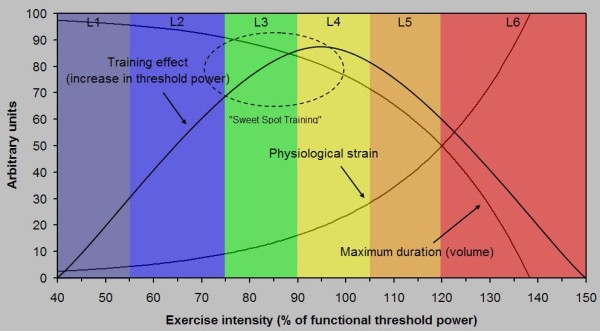By Gordon Paulson, PCG Elite/Master Coach

Understanding power zones can unlock the impressive potential of your power meter and ensure your training is targeted to take you to the next level of performance. Not all coaches use the same description of training zones; the names, values, and even labels vary among the different systems. Here at Peaks Coaching Group we use the seven zones developed by Dr. Andy Coggan for training with power. Each of these zones is expressed as a percentage of functional threshold power (FTP). The time you can sustain a continuous effort in the power zone (“burn time”) decreases as the wattage for the zone increases. Keep in mind, however, that these changes take place on a continuum and are not represented by “bright line” points.
Click through for more on each zone…
L1: Active Recovery (AR)
Active recovery zone intervals occur when you maintain power below 55% of your FTP. It isn’t time limited; theoretically you could ride steadily in the active recovery zone without running out of energy (as long as you’re refueling, hydrating, etc.). The key word in the label is recovery! This is probably the most difficult zone to ride in consistently; most athletes tend to ramp it up a bit when the terrain, conditions, or fellow riders create an opportunity. One athlete I’ve worked with has become very capable at riding true active recovery, and he describes the sensations in his legs while riding active recovery as “letting the weight of the shoe move the pedal.” He actually selects his routes to make it easier to stay in his active recovery zone. Not surprisingly, he has developed faster and to a higher watts/kilogram than any other high-level cyclist I’ve seen.
L2: Endurance
Intervals in the endurance zone occur when power is maintained between 56% and 75% of your FTP. A well-trained athlete can maintain a continuous endurance zone effort for a very long time; as Dr. Andy Coggan suggests, we can ride endurance zone “between two and a half hours to two weeks. Cyclists who ride a lot spend a lot of time in their endurance zone. The ability to do this is not especially helpful when doing criteriums or road races, but Ironman triathletes and racers doing epic rides (such as the Race Across America) live in this zone.
One athlete I worked with loved riding in this zone so much that he routinely added three or four hours to his workouts, with the extra time almost always spent in his endurance zone. Eventually, perhaps in part due to his love for this zone, this athlete decided to transition from local road racing to long distance events like the Race Across America.
L3: Tempo
When you ride in your tempo zone, you’re maintaining power between 76% and 90% of your FTP. Efforts in this power zone can be maintained for durations between two and a half and eight hours. Long course triathletes (half and full Ironman events) may spend a great deal of their bike leg riding time in this zone, but full Ironman bike legs (followed by a full marathon run!) should not be targeted in this zone, as the burn time for tempo efforts would guarantee the triathlete runs out of energy before running out of race.
This is kind of the in-between zone. Structured intervals are rarely designed to work in the tempo zone in training situations, though I will include a fair amount of work in this zone as race season approaches. Intervals targeting a tempo training effect must generally be about two and a half hours. Athletes who do a large number of group rides may find that much of their ride time occurs in this zone. This is predictable due to the burn time for the efforts in the zones above tempo. As a coach I often discuss the need to avoid large amounts of riding in the tempo zone for athletes working to improve their TT or criterium efforts, since time spent in tempo isn’t doing much to improve performances in those type of events.
L4: Threshold
The threshold zone is extremely important to you as a developing cyclist. You are training in this zone when your wattage is between 91% and 105% of your FTP. By definition, you should be able to maintain an effort in this zone for sixty minutes. In order to trigger a threshold training effect, intervals in this zone should be at least ten minutes long. Many of the structured workouts I design target this zone, because FTP is so important to your overall training levels, and it is crucial to increase your FTP in order to improve your performance in zones 1-4.
L5: VO2Max
Intervals targeting your VO2Max have a wattage goal of 106% to 120% of your FTP and must be approximately three minutes long to have a VO2Max training effect. Most mortal cyclists can maintain efforts in the VO2Max zone for no more than eight minutes of burn time. Intervals at this level are very intense and must be approached with care; when an athlete does VO2Max efforts it is important to closely monitor training stress, in terms of both intensity and volume, to guard against overtraining. Improvement in VO2Max is hard to come by, and when it does occur it never comes in large amounts. Doing VO2Max intervals will create a high level of fatigue and often legs that literally hurt after workouts and for days afterward. To be effective, VO2Max intervals should only be attempted following effective periods of recovery.
L6: Anaerobic Capacity (AC)
Anaerobic capacity intervals are done in the wattage range of 121% to 150% of FTP. The burn time” for AC intervals is approximately two minutes, but it is a rare athlete who can maintain this level for that long. The floor duration to trigger an AC training effect is about thirty seconds. These are high intensity, hard intervals, and workouts focused on this training zone are generally dreaded by athletes.
I prescribe an AC workout that has become popular with a number of my athletes; it’s done in pairs and involves one rider drafting the other and then the drafting rider “attacking” her partner. The partner must then jump onto the wheel of the attacking rider, and both of them continue a maximum ~150% effort for a total time of thirty seconds. They recover for three minutes and repeat the workout, switching the roles so the attackee becomes the attacker. One of my athletes who had historically disliked AC interval work confided to me that this workout was able to sneak in AC intervals she would normally dread on her own.
L7: Neuromuscular Power (NP)
Training in the neuromuscular power zone is as intense as it gets! This zone isn’t targeted toward specific wattage; you simply go as hard as humanly possible for at least five seconds. The burn time for this type of effort is about 15 seconds. One of my athletes who is an engineer and very much a “numbers type” told me that the reason there’s no power number targeted for NP efforts is that if you’re doing them correctly you can’t see straight to even note what numbers your wattage meter is displaying. Your legs really take a beating when doing NP interval work, and it’s not a good idea to do consecutive days of NP intervals; adequate rest and recovery is an absolute must before repeating intervals at this level.
Things to keep in mind
- Power training zones are based upon an accurate, current measurement of your FTP. FTP must be rechecked at regular intervals (every four to six weeks) so that your zones can be accurately adjusted.
- Percentage of heart rate (HR) is not the same as percentage of FTP. Click here for more on that topic.
- These are zones. You’re working on training specific energy systems (e.g. VO2Max, threshold, endurance, etc.) when you train within the power numbers for the zone for an appropriate amount of time.
- The necessary time in the zone to trigger a training effect varies with each zone and with where your power is relatively within the zone. For example, intervals in your threshold zone should last at least ten minutes to get a threshold training effect, but if you do a threshold interval at the low end of your threshold zone (for example, at 96% of your FTP), you might need to do intervals of at least 12-13 minutes to trigger the same training effect that you get from doing ten-minute intervals at 100% of FTP.
Sweet Spot Intervals
Power zone workouts are usually designed to have you produce wattage at a level in the zone for a specific amount of time, with a specific amount of recovery. The “sweet spot” workout, however, crosses the boundaries between zones to produce a threshold training effect. Compared to threshold level intervals, this type of workout makes it possible for you to do more and longer intervals. That’s what makes it sweet!
To perform a sweet spot interval workout, you should ride for twenty minutes at 88-92% of your FTP. Try to perform two of these intervals with at least five minutes of recovery between intervals. When you can complete two twenty-minute sweet spot intervals in a workout relatively easily, you should add a third. Dr. Andy Coggan created the following chart that graphically shows how the sweet spot can improve threshold while limiting physiological strain to an optimal level (credit goes to Dr. Andy Coggan, PhD for the diagram).
Want expert help identifying your training zones? Find out more about our coaching or schedule a consulting session with one of our expert coaches. With power training, we get powerful results.
 Gordon Paulson is a Cat 1 racer, a Level 2 USAC cycling coach, a Peaks Coaching Group elite/master coach, a practicing attorney, and a father of three in Cottage Grove, Wisconsin. He has extensive road racing experience and has set numerous course records in Wisconsin and Minnesota, many of which have now been eclipsed by his own athletes. Gordon can be contacted through info@peakscoachinggroup.com or www.peakscoachinggroup.com.
Gordon Paulson is a Cat 1 racer, a Level 2 USAC cycling coach, a Peaks Coaching Group elite/master coach, a practicing attorney, and a father of three in Cottage Grove, Wisconsin. He has extensive road racing experience and has set numerous course records in Wisconsin and Minnesota, many of which have now been eclipsed by his own athletes. Gordon can be contacted through info@peakscoachinggroup.com or www.peakscoachinggroup.com.
